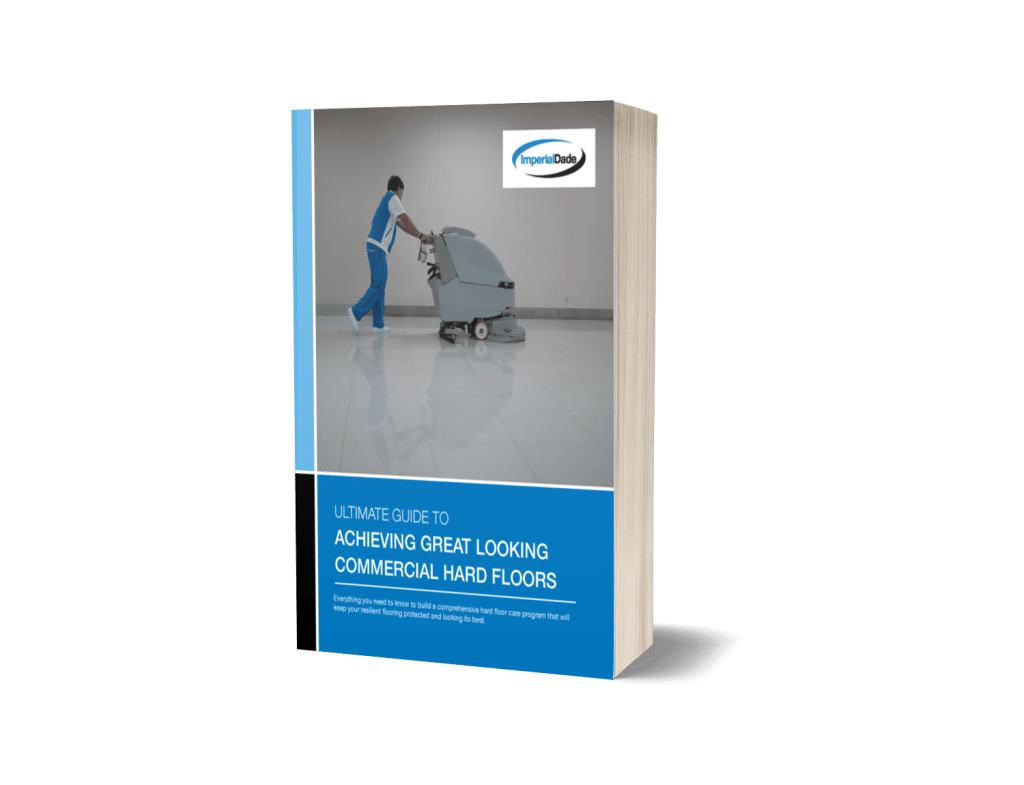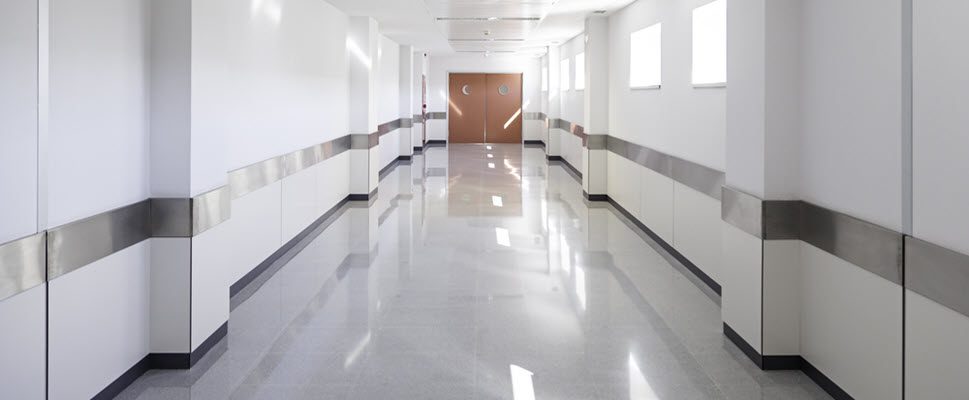Floors are the first thing people notice when they enter your facility. They are also a major investment in both time and money.
Maintaining the appearance of your hard floors requires daily cleaning and maintenance to remove soil that is tracked into your facility, decrease damage to your floors, and reduce the frequency of periodic or restorative hard floor care procedures that are more time-consuming and expensive.
90% of the soil in a building is tracked in from the outside. Without daily cleaning and maintenance procedures, floors can easily become damaged by abrasive soils and debris. Soils, like sand, cut and scratch hard floors, wearing down the floor finish and creating a dull appearance.
In this article, we will cover the recommended daily cleaning and maintenance procedures to maintain the appearance and extend the life of your resilient hard floors.
Everything you need to know about resilient hard floors including how to maintain them for best results, troubleshooting, & more!

So what do we mean by resilient hard floors? Floors that have some give in them but quickly return to their original condition.
Some examples of resilient hard floors include:
- Vinyl Composition Tile (VCT)
- Vinyl Asbestos Tile or Asphalt Tile (VAT)
- Luxury Vinyl Tile (LVT)
- Linoleum
- Rubber
Understanding the components of a comprehensive commercial floor maintenance program is critical to achieving long-lasting, brilliant hard floors.
Performing these 4 things daily will help keep your commercial resilient floors looking great:
- Clean/Empty Entry Matting
- Sweeping
- Dust Mopping or Vacuuming
- Damp Mopping or Cleaning with an Auto Scrubber
1. Clean/Empty Entry Matting
Daily commercial hard floor maintenance begins with emptying soil from entry matting.
Entry mats are the first line of defense for your facility’s floors. The best way to protect your floors is to prevent soil from entering in the first place.
CleanLink reports that 85% of the dirt from outdoors can be stopped from entering your building with proper entry matting.
To remain effective, entry mats must be emptied to remove buildup of soils.
Entry mats have a limit to the amount of dirt that they can hold. Mats which are too full are not effective at removing dirt from guest’s shoes and allow for the soil to be tracked beyond the entrance of your facility.
Entry matting should be vacuumed to remove dirt and soils at least once a day.
Limiting the amount of abrasive soils, such as salt or sand, is a critical component to limiting scratches and damages, which will dull your hard floors.
To remove soil from entry mats, vacuum in straight lines. Make a forward and backward pass, one over the other to make a complete pass. To move forward, overlap the previous pass by 2-3 inches to ensure that the entire mat is vacuumed.
Remove floor mats to prepare for the next floor cleaning procedures.
2. Sweeping
Sweeping is the second step in daily hard floor care. Sweeping removes large dirt and soils such as papers, wrappers, or small trash items from the area.
If there is no large debris present, then sweeping can be skipped and you can go directly to vacuuming and dust mopping.
For large open areas like hallways or cafeterias, choose the largest broom available. Choosing a large broom will allow you to be as efficient and productive as possible. Sweep the area from one end of the space to the other, creating a central garbage pile.
For congested areas such as classrooms or offices, you will likely need a smaller broom to get under desks or behind objects. You should begin your sweeping at the back of an area and progress forward. Soil should be swept into small piles in the aisle and then removed with a dustpan.
To sweep stairways, begin at the top of the stairway and work your way down. Sweep each stair from the outer edges in. Move the soil and debris downward as you progress down the stairs, ultimately collecting the debris in a dustpan on the last stair.
3. Dust Mopping or Vacuuming
The next step in daily hard floor maintenance is dust mopping or vacuuming. Dust mopping and vacuuming removes smaller soils and dust particles that sweeping does not remove.
This is the most critical step in a quality floor maintenance program.
When dust mopping, select the largest dust mop that will be efficient.
For mopping small, congested areas choose a smaller mop such as the 8-inch or 12-inch dust mop.
Large, open areas can accommodate mops that are larger such as the 48-inch, 60-inch, or 72-inch dust mop.
Pro Tip: Using a microfiber mop can provide increased cleaning efficacy over traditional mops. The more soils that are removed, the more productive you can be, allowing you to get more done during a shift.
Run the dust mop over the entire floor surface. Do not remove the dust mop from the surface of the floor, and try to limit shaking. Picking up the mop or shaking the mop will cause dust particles to become airborne.
According to an article on CleanLink, vacuuming is a better method for removing soils if the proper equipment and cleaning path are used.
Vacuuming can provide reduced cleaning times and increased productivity when compared to dust mopping.
Selecting the best vacuum for your facility will depend on the size of the area being cleaned and your facility’s budget.
When vacuuming, the best cleaning path will allow you to continuously move forward without backtracking over areas that were already cleaned. Additionally, the best route will minimize the number of times you have to move the power cord to a new outlet, reducing the risk of injury and equipment damage and allowing you to get more done.
In most facilities, hard floors should be vacuumed at least once a day but may differ depending on traffic and soil levels. Higher traffic areas, like entryways, will likely gather more soil and require more frequent vacuuming.
4. Damp Mopping or Cleaning with an Auto Scrubber
The final procedure to include in your daily hard floor maintenance program is damp mopping or cleaning the area with an auto scrubber.
Damp mopping uses a mop and bucket system. The mop should be tightly wrung out to avoid overly wetting the floor.
When damp mopping, divide the area to be cleaned in 10 ft by 10 ft areas. Mop the area in an “s” or “figure 8” pattern.
Pro Tip: Don’t forget to place wet floor signs outside the area being cleaned. Wet floors can pose a slip and fall hazard to guests.
In some facilities, auto scrubbers can replace the traditional mop and bucket system.
Auto scrubbers are large pieces of janitorial cleaning equipment that remove the manual labor otherwise required when mopping a floor.
The machines are equipped with automated systems to scrub and dry your facility’s floor in one pass.
Auto scrubbers clean floors with increased power and a reduced amount of water and solution, providing quicker dry times and a more hygienic clean. In addition, auto scrubbers provide a significant reduction in labor time, the single biggest cost in any cleaning program.
Interested in learning more about auto scrubbers? Check out our article, “What is an Automatic Floor Scrubber (Types, Sizes, & Features)”.
If you choose to use an auto scrubber, select a pad that will not be too aggressive on the floor finish for everyday use. We recommend the use of a red floor pad for everyday cleaning and light scrubbing procedures.
Not all floor types are tolerant of the same commercial cleaning chemicals or pad pressure.
Check the floor manufacturer guidelines for the chemical and floor pad compatibility with your floor type.
Final Thoughts
Dull and scratched floors can negatively affect the appearance of your facility.
Performing these daily floor care procedures will keep your hard floors looking great and can prevent the need for more costly restorative procedures, extend the life of your floor, and safeguard your investment.
Imperial Dade has a wide range of commercial cleaning products and janitorial equipment to make daily maintenance of your facility’s resilient hard floors easier.
If you’re located in the United States, Puerto Rico, or the Caribbean, contact an Imperial Dade Specialist for a review of your current cleaning protocols to make sure you’re using the best products and procedures.
